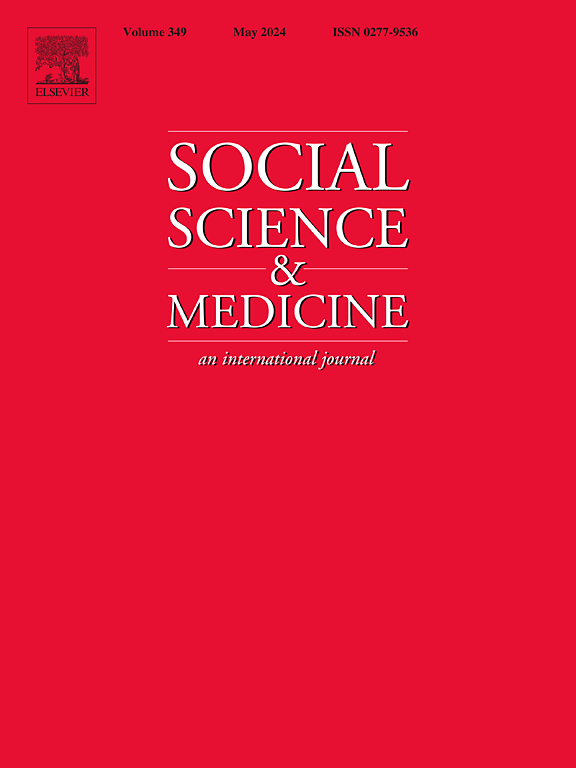Do type, timing and duration of life course non-employment differentially predict dementia risk? An application of sequence analysis
IF 4.9
2区 医学
Q1 PUBLIC, ENVIRONMENTAL & OCCUPATIONAL HEALTH
引用次数: 0
Abstract
Periods out of employment may influence dementia, but characterizing lifecourse employment is difficult and prior research is sparse. This study used sequence and cluster analysis to characterize type, timing, and duration of lifecourse work gaps and estimate associations with dementia risk.
Life History Mail Survey supplement to the U.S. Health Retirement Study participants (N = 5,945, 13.6 % of the Health and Retirement Study sample) reported lifecourse employment (full time or part time) and reasons and age of work gaps (unemployment, schooling, caregiving, or disability). Our exposure was gender-stratified employment trajectories from age 18–65, characterized using sequence analysis and cluster analysis. Our outcomes were algorithmically defined dementia probability scores and memory scores. We estimated the association between employment trajectories and dementia risk using generalized estimating equations and memory decline using linear mixed effect models, adjusted for age, gender, birthplace, and childhood socioeconomic status.
We identified 11 employment trajectories for women (including predominant work, disability, unemployment, caregiving, retirement) and 10 for men (similar, but no caregiving). Compared to “predominant work”, “disability” and “unemployment” trajectories were associated with higher dementia risk for men and women (e.g., disability among women: OR = 3.62; 95 % CI = 2.25, 5.81). Among women who cared for family, those who did not re-enter the labor force full-time had higher dementia risk (e.g. “family gap, go back part time”: OR = 1.79; 95 % CI = 1.15, 2.79) compared to the predominant work cluster. Women who cared for family and returned to full-time work had similar cognitive outcomes to those in the predominant work cluster. Men who had long spells of part-time work also had elevated dementia risk (e.g. part time earlier: OR = 1.64; 95 % CI = 1.16, 2.57). Finally, women and men with long periods of unreported employment status had higher dementia risk than those in the predominant work trajectory.
Results suggest the type, timing and duration of work gaps are differentially associated with dementia risk. Work gaps due to disability, unemployment or unreported employment status predicted higher dementia risk. Permanently leaving full-time work for caregiving predicted worse cognitive outcomes but temporary caregiving-related work interruptions did not.
非就业的类型、时间和持续时间对痴呆风险的预测有差异吗?序列分析的一个应用
失业期可能会影响痴呆症,但描述生命过程中的就业是困难的,先前的研究也很少。本研究使用序列和聚类分析来描述生命过程中工作间隙的类型、时间和持续时间,并估计其与痴呆风险的关系。美国健康退休研究参与者(N = 5,945,占健康和退休研究样本的13.6%)的生命历程邮件调查补充报告了一生的工作(全职或兼职)以及工作间隔的原因和年龄(失业、上学、照顾或残疾)。我们的暴露是性别分层的就业轨迹,从18-65岁,使用序列分析和聚类分析特征。我们的结果是算法定义的痴呆概率得分和记忆得分。我们使用广义估计方程估计就业轨迹与痴呆风险之间的关系,使用线性混合效应模型估计记忆力下降,并根据年龄、性别、出生地和童年社会经济地位进行调整。我们确定了女性的11个就业轨迹(包括主要工作、残疾、失业、照顾、退休)和男性的10个就业轨迹(类似,但没有照顾)。与“主要工作”相比,“残疾”和“失业”轨迹与男性和女性较高的痴呆风险相关(例如,女性残疾:OR = 3.62;95% ci = 2.25, 5.81)。在照顾家庭的妇女中,那些没有重新全职进入劳动力市场的妇女患痴呆症的风险更高(例如,“家庭差距,回去兼职”:OR = 1.79;95% CI = 1.15, 2.79)。那些照顾家庭并重返全职工作的女性与那些主要工作群体的女性有着相似的认知结果。长期从事兼职工作的男性患痴呆症的风险也较高(例如,较早从事兼职工作:OR = 1.64;95% ci = 1.16, 2.57)。最后,长期未报告就业状况的女性和男性患痴呆症的风险高于那些处于主导工作轨迹的人。研究结果表明,工作间隔的类型、时间和持续时间与患痴呆症的风险存在差异。残疾、失业或未报告的就业状况导致的工作间隔预示着更高的痴呆症风险。永久离开全职工作去照顾孩子会导致更糟糕的认知结果,但与照顾孩子有关的工作暂时中断却不会。
本文章由计算机程序翻译,如有差异,请以英文原文为准。
求助全文
约1分钟内获得全文
求助全文
来源期刊

Social Science & Medicine
PUBLIC, ENVIRONMENTAL & OCCUPATIONAL HEALTH-
CiteScore
9.10
自引率
5.60%
发文量
762
审稿时长
38 days
期刊介绍:
Social Science & Medicine provides an international and interdisciplinary forum for the dissemination of social science research on health. We publish original research articles (both empirical and theoretical), reviews, position papers and commentaries on health issues, to inform current research, policy and practice in all areas of common interest to social scientists, health practitioners, and policy makers. The journal publishes material relevant to any aspect of health from a wide range of social science disciplines (anthropology, economics, epidemiology, geography, policy, psychology, and sociology), and material relevant to the social sciences from any of the professions concerned with physical and mental health, health care, clinical practice, and health policy and organization. We encourage material which is of general interest to an international readership.
 求助内容:
求助内容: 应助结果提醒方式:
应助结果提醒方式:


